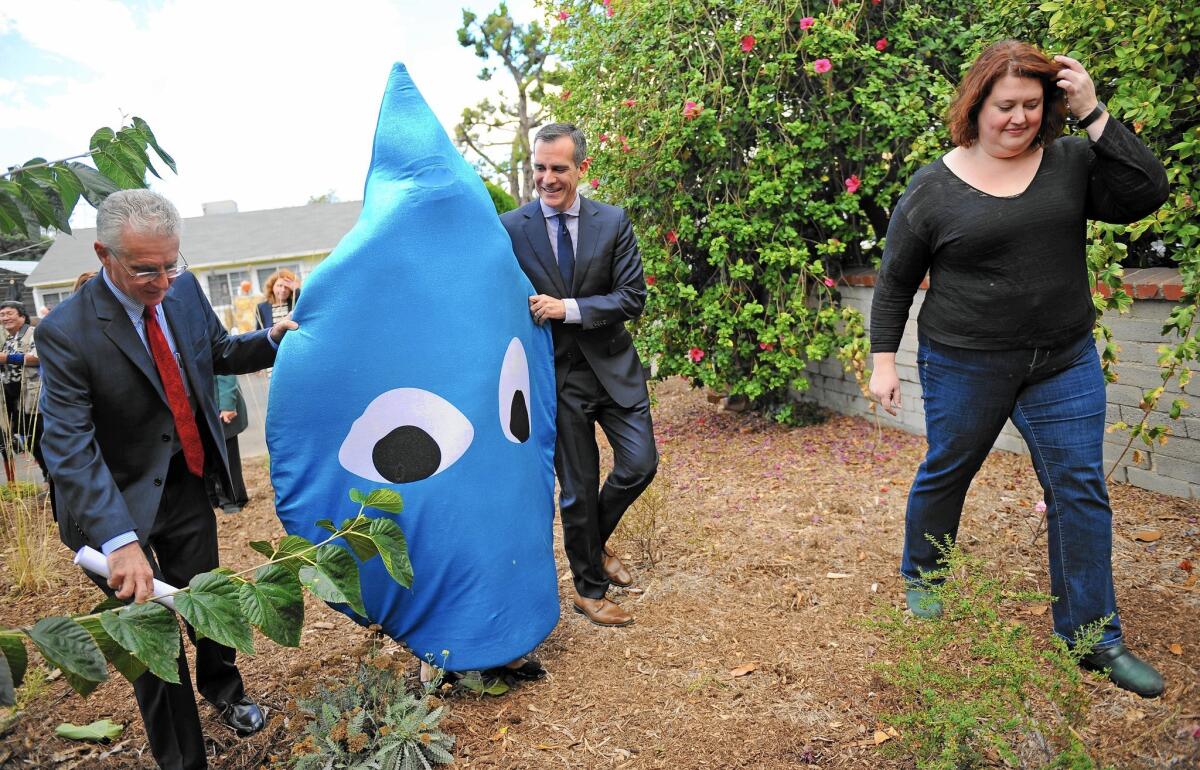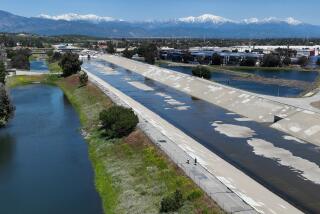High-tech water-saving system draws a crowd at North Hollywood home

Whether she’s driving a hybrid car, installing solar panels on her roof or tearing up her beloved front lawn and replacing it with mulch, Carrie Wassenaar said, she wants to do her part for the environment.
“I try to be responsible,” the 39-year-old animation line producer said. “I want to feel like I’m doing my best to live efficiently.”
So when Wassenaar heard of a pilot program to retrofit homes with a computerized system that captures storm water and then stores it in a massive 1,300-gallon cistern for residential use, she jumped at the chance.
Scores of reporters, officials and environmental advocates descended on Wassenaar’s small North Hollywood home this week to catch a glimpse of her newly installed StormCatcher system as Los Angeles Mayor Eric Garcetti and County Supervisor Sheila Kuehl activated it with the touch of an iPad.
The system is a joint effort of the city of Los Angeles, Los Angeles County, the nonprofit group TreePeople and the engineering firm Tetra Tech. The pilot program will include up to 10 homes, but advocates hope the system will ultimately be used by homes throughout the county.
Wassenaar’s roof, or at least the side without solar panels, has been outfitted with gutters and downspouts to capture all rain in a 900-square-foot area. That water is funneled to a network of underground pipes and then into a green plastic tank that sits beneath a lemon tree in Wassenaar’s backyard.
“People say, ‘I don’t want a tank in my yard because it’s an eyesore,’ but I think I’m lucky to have it,” Wassenaar told reporters during a tour.
While there’s a spigot on the tank to let Wassenaar use the water for non-potable purposes, the tank can also drain into a “rain garden” in the frontyard.
The rain garden is a depression that contains stones and rocks and allows large amounts of storm water to pool instead of flowing into the street. Eventually, the pooled water percolates through the ground and into the San Fernando Valley groundwater basin, recharging the aquifer.
The high-tech aspect of the StormCatcher program involves a computerized control panel that is attached to the side of Wassenaar’s home. This controller monitors the water level in the cistern and controls the release of water into the rain garden.
The controller also provides data to officials who are evaluating the pilot program, and it will trigger water releases based on weather forecasts. (If a big storm is coming and the tank is full, it will flush water into the rain garden to make room for the system to capture more storm water.)
Officials say a vast network of homes outfitted with such systems might prove to be a modern-day answer to flood control. Kuehl noted that the flood control system that currently crisscrosses the county is 100 years old and was designed to flush rainwater into the Pacific Ocean.
She and other officials say that, after years of drought, they must now consider a system to prevent flooding but also allow rainwater to recharge underground aquifers.
In the case of Wassenaar’s system, it would take more than 2 inches of rainfall to fill the cistern, officials said. During an average year, the system will collect at least 7,000 gallons of water.
Officials say that by encouraging residents to capture and store rainwater they can lower their water bills, help eliminate incidents of neighborhood flooding and reduce the amount of pollutants that runoff washes into the sea.
The system isn’t cheap, however. While the low-tech components of the system could be installed for several thousand dollars, the high-tech control panel brings the price to $25,000.
Andy Lipkis, founder and president of TreePeople, has been advocating rainwater storage systems for decades. He said that, while such systems might be expensive now, the price would fall over time — much the way the price of solar panels has fallen — and that plans are in the works for a rebate program.
“If it works, and that’s part of what we’re testing, it’s something that would be subsidized by the government because they’ll share control of the system with the homeowner,” Lipkis said.
Twitter: @montemorin
ALSO
L.A. leaders warn Angelenos to prepare for ‘Godzilla’ El Niño storms
China, Taiwan presidents meet with historic handshake
Why huge ‘SNL’ ratings won’t help Donald Trump become president







